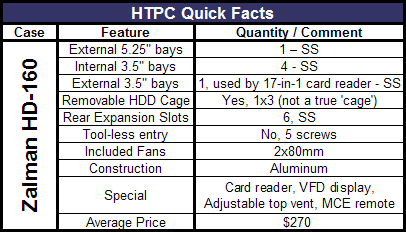Zalman HD-160 and Accompanying Products
by Joshua Buss on March 31, 2006 12:05 AM EST- Posted in
- Cases/Cooling/PSUs
Introduction
It hasn't been that long since we last examined the HTPC scene, and afterwards, we were starting to wonder if anyone knew just exactly what it took to engineer a perfect HTPC case. We say this not because the last four cases we reviewed were poor performers, but simply because it seems like each one managed to just barely miss something that, when it comes right down to it, is pretty important in an home theater case.
Zalman hasn't had much of a history in case design per se, but their presence in the cooling industry is now practically ubiquitous. Starting especially with the fantastic 7000 series CPU coolers, and also with the outlandishly extreme TNN500A 100% passive case, they've made a name for themselves as the forefront proponents of silent computing.
Now going directly after the HTPC market, Zalman has recently released the HD-160 case, a moderately sized, mid-to-high priced, 100% aluminum ATX compatible chassis available in black and silver, and accompanying our review of the case, we'll be looking at their latest power supply, the ZM460-APS, their latest CPU cooler, the CNPS-9500, and their popular GPU cooler, the VF700-Cu.
First, we'll examine the case and test it using the same hardware that we've used to test our other HTPC cases, but then we'll switch our standard ATX test bed's CPU and GPU coolers for Zalman's and analyze how the performance changes.
For more information on the HD-160 and the other products in this review, please check out Zalman's website.
It hasn't been that long since we last examined the HTPC scene, and afterwards, we were starting to wonder if anyone knew just exactly what it took to engineer a perfect HTPC case. We say this not because the last four cases we reviewed were poor performers, but simply because it seems like each one managed to just barely miss something that, when it comes right down to it, is pretty important in an home theater case.
Zalman hasn't had much of a history in case design per se, but their presence in the cooling industry is now practically ubiquitous. Starting especially with the fantastic 7000 series CPU coolers, and also with the outlandishly extreme TNN500A 100% passive case, they've made a name for themselves as the forefront proponents of silent computing.
Now going directly after the HTPC market, Zalman has recently released the HD-160 case, a moderately sized, mid-to-high priced, 100% aluminum ATX compatible chassis available in black and silver, and accompanying our review of the case, we'll be looking at their latest power supply, the ZM460-APS, their latest CPU cooler, the CNPS-9500, and their popular GPU cooler, the VF700-Cu.
First, we'll examine the case and test it using the same hardware that we've used to test our other HTPC cases, but then we'll switch our standard ATX test bed's CPU and GPU coolers for Zalman's and analyze how the performance changes.

(TL: Tool-less, TS: Thumbscrews, SS: Standard Screws)
For more information on the HD-160 and the other products in this review, please check out Zalman's website.










48 Comments
View All Comments
krwilsonn - Saturday, April 1, 2006 - link
"edit" Ok so it says the PSU is a separate product in the first paragraph. Nevermind my inquiry about that. Also, to the author, nice work on the JPEG's... no complaints here (???)nullpointerus - Saturday, April 1, 2006 - link
It's more cost efficient to get longer cables and move the HTPC away from the listening position(s). And you might even be able to find an external DVD burner to sit on your entertainment center and run a 10 ft. USB or Firewire cable to the HTPC.Fluffiette - Friday, March 31, 2006 - link
:-*logeater - Friday, March 31, 2006 - link
Worst. Case. Ever.logeater - Friday, March 31, 2006 - link
first...DigitalFreak - Friday, March 31, 2006 - link
not...creathir - Friday, March 31, 2006 - link
This thing is TOO big for my tastes.When I think HTPC, I think small, quiet, & compact. This sucker is about the size of a normal ATX case, laid on its side.
- Creathir
BornStar18 - Friday, March 31, 2006 - link
The advantage I see to this case is that it seems to be the same size as a reciever. That would mean that it wouldn't mess with your ability to stack devices like the half depth DVD players or narrow TiVos and VCRs. I see the size as a good thing.